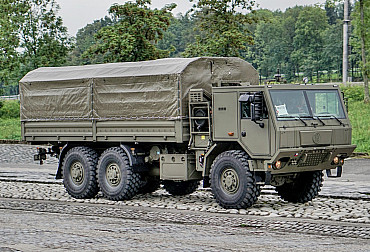Strengthening Israel's defenses: U.S. sends THAAD Missile System and troops in response to regional threats
The United States has announced a significant escalation in its military support for Israel, confirming the deployment of a sophisticated Terminal High Altitude Area Defense (THAAD) missile battery and associated personnel to Israel. This move comes at a critical time, as tensions continue to mount in the Middle East following a series of missile exchanges and military actions, particularly between Israel and Iran, as well as between Israeli forces and Hezbollah fighters in Lebanon.

The Deployment of THAAD to Israel
The THAAD system, a highly advanced missile defense platform designed to intercept ballistic missile threats, is being sent as part of the U.S. effort to strengthen Israel’s air defenses. Pentagon spokesperson Maj. Gen. Pat Ryder explained that Defense Secretary Lloyd Austin authorized the deployment under the direction of President Joe Biden. The official statement emphasized that the move was intended to bolster Israel's defenses following recent missile attacks by Iran, which targeted Israeli territories in both April and October of 2023. These assaults marked a notable intensification of hostilities in the region and were seen as a direct threat to Israel’s security.
While the Pentagon has refrained from disclosing specific details about the deployment timeline, the decision underscores the longstanding military alliance between the U.S. and Israel. Lt. Col. Nadav Shoshani of the Israeli army expressed gratitude for the U.S. support, but also withheld further information regarding the arrival of the THAAD battery.
Strategic Significance of THAAD
The THAAD system represents a critical addition to Israel’s already robust missile defense architecture. The THAAD platform, developed by the U.S. Missile Defense Agency but operated by the Army, offers a highly capable shield against short-range, medium-range, and limited intermediate-range ballistic missile threats. It complements Israel’s existing defense systems, which include the Iron Dome and David’s Sling, designed to intercept threats of varying range and sophistication.
Unlike the older Patriot missile systems, which Israel recently phased out after decades of service, THAAD can engage targets both within and outside the Earth's atmosphere at ranges of 150 to 200 kilometers (93 to 124 miles). This capability provides a broader protective umbrella for Israel, crucial in light of the complex and multi-dimensional nature of threats emanating from regional actors like Iran and Hezbollah.
A typical THAAD battery includes six truck-mounted launchers, radar equipment, communication units, and up to 48 interceptors. The deployment also requires 95 soldiers to operate the system, reflecting the scale of the U.S. military's commitment to supporting its ally during this volatile period.
Rising Conflict: Israel, Iran, and Hezbollah
The deployment of THAAD comes amidst intensifying violence between Israel and Hezbollah, the Lebanese militant group with close ties to Iran. Hostilities flared on October 8, 2023, when Hezbollah began firing rockets into northern Israel in an apparent show of solidarity with Hamas, another Iranian-backed group involved in the ongoing Gaza conflict. In response, Israel launched a ground invasion into southern Lebanon, escalating tensions further.
Adding to the strain, Iran fired approximately 180 missiles into Israel on October 1, 2023, marking one of the most significant direct confrontations between the two nations in years. This attack is believed to be in retaliation for earlier Israeli military actions, and many analysts anticipate that Israel is preparing a substantial military response. Iran's Foreign Minister Abbas Araghchi, via a post on the platform X (formerly known as Twitter), warned the U.S. to stay out of Israel, signaling Tehran’s discontent with American military involvement.
U.S. Commitment to Israel’s Defense
In remarks made to reporters at MacDill Air Force Base in Florida, President Biden reaffirmed the U.S. dedication to defending Israel from missile attacks, stating, "We are deploying this system to defend Israel." Biden's comments came during a brief stopover to assess damage from Hurricane Milton, but they underscored the gravity of the situation in the Middle East and the U.S.'s role in it.
This deployment is not the first time the U.S. has sent missile defense systems to Israel. A THAAD battery was previously deployed in 2019 as part of joint training exercises, and additional Patriot missile battalions were stationed in the Middle East to protect U.S. personnel after the October 7, 2023, attack by Hamas militants. The consistency of U.S. military presence in Israel and other parts of the region highlights the importance Washington places on Israel’s security as part of its broader Middle Eastern strategy.
Risks of Further Escalation
While the THAAD deployment is a defensive measure aimed at protecting Israel from ballistic missile threats, it risks further exacerbating tensions in the already volatile region. Iran's stern warning to the U.S. against increasing its military footprint in Israel underscores the delicate nature of the current situation. Diplomatic efforts to de-escalate the conflict have so far been unsuccessful, raising concerns that the introduction of additional military assets could provoke a broader conflict involving multiple regional actors.
The Middle East has long been a hotspot for geopolitical strife, and the current situation is no exception. The involvement of powerful players like the U.S., Israel, Iran, and Hezbollah in the current conflict highlights the precarious balance of power in the region. For now, the U.S. appears committed to standing by its ally Israel, even as it navigates the challenges of maintaining stability and preventing further conflict escalation.
Conclusion
The U.S. deployment of the THAAD missile defense system to Israel reflects the strong military partnership between the two nations and Washington's determination to support Israel amidst escalating regional threats. As the situation in the Middle East continues to evolve, this move could play a pivotal role in shaping the future of the conflict. However, it also carries significant risks, particularly in terms of potentially heightening tensions with Iran and Hezbollah. As diplomatic efforts continue, the world will be watching closely to see how this complex situation unfolds.








